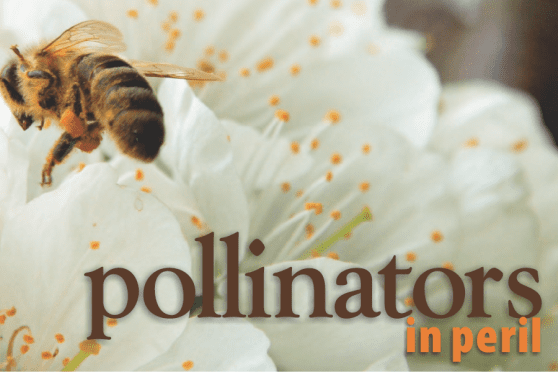an interview with Jamie Walters

- Jamie, pollinators seem to be a hot topic these days, can you explain your interest in promoting them?
Since taking the Pollinator Specialists class with Denise Ellsworth at OSU, it has really opened my eyes to our needs of having pollinators. When some people think pollinators, they only think of honeybees, in which they are missing all types of bees, bumble bees, leaf cutter bees, long-horned bees, mason bees, minor bees, oil-collecting bees, sweat bees, & yellow faced bees. We have over 500 species of bees just in Ohio, let alone the ants, beetles, birds, butterflies, flies, moths & some wasps that also pollinate our flowers, trees, plants, and vegetables.
These animals help to pollinate nearly 75% of our food crops; apples, strawberries, plums, peaches, and 35% indirectly contribute to our food chain; alfalfa and clover for animal forage/feed, dairy and beef. Most of your fresh fruits and vegetables would disappear from our grocery stores shelves without pollinators. The best examples I can give that would affect most people are:
Chocolate – Cocoa beans could not develop from not being pollinated. The milk from dairy cow would significantly be reduced from the alfalfa and clover that it needs to eat, which is pollinated to help produce seed to grow more alfalfa and clover.
Beef, pork, poultry and lamb – derived one way or another from insect pollinated legumes such as alfalfa, clover, lespedeza, and trefoil.
Coffee – directly impacted as it requires pollinators to set seed; coffee bean. - Why do you believe pollinators populations are at risk?
Forage: Through research of State Colleges, USDA, Pollinators Partnership, and more, there is solid concrete proof that forage is disappearing at alarming rates. The pollinators use the pollen as their protein to consume, reproduce, and store to get through periods when pollen is not available. This is no different than humans going to the grocery store to eat their next meal or put it in the cupboards for next week. Do you enjoy going to the corner market, local grocery store or what if you had to go to Toledo or Ft. Wayne every time you wanted nourishment? Pollinators require pollen from the first signs of skunk cabbage blossoms, dandelion, white Dutch clover through summer till golden rod and asters in the late Fall.
Chemicals: Pesticides, herbicides, insecticides, and fungicides are becoming an increasing concern. There is an ever growing abundance of chemicals on the store shelves. Knowing what to spray, when to spray, and even if you need to spray should be everyone’s responsibility. Properly identifying the pest first, either by reaching out to your County OSU Extension Office, Soil & Water Conservation District, or trained personnel, you can then react to what needs to be done. Using an integrated pest management (IPM) practice will help reduce chemicals in our environment and always follow label directions. There is research & development that goes into writing them, placing an extra doing no good to you or the environment.
Humans: Wanting the perfect green lawn, spraying chemicals, cutting back native areas and/or trees and best management practices. - Where do honey bees fit into this equation?

On January 10, 2017 the United States Fish and Wildlife Service placed the rusty patched bumblebee (B. affinis) on the list of endangered species. Honeybees are a big part of this because we place them into a hive, manage, and they are the only insect that humans get a product from – honey. Since we can move our hives to any location for pollination of apple orchards, vegetable gardens, strawberry fields, and many others, we tend to see first-hand if there is enough forage in the areas. If there isn’t enough forage for native pollinators, they move out of that area or go extinct, as in the case of the Rusty Patch Bumblebee here in Ohio. Beekeepers, like myself can use tools; Google Earth to look for proper forage areas for our beehives and move them, if needed. Knowing that from each hive, our honeybees will forage in a maximum 5 mile radius, approx. 50265.5 acres. Pollinators contribute more than $20 million dollars to the United States economy, of which honeybees account for more than $15 million dollars through their vital role in keeping, fruits, nuts, and vegetables in our diets.
- What can people do to help?
If everyone would help just a little, the impact would be tremendous. Having a “Spray Free Zone” on your property. Planting and landscaping with Ohio native plants; milkweed, purple cone flower, cup plant, joe pye weed, etc. Allowing their lawns to grow dandelions, white Dutch clover, or just allowing an area of their lawn to grow will. I ask everyone to take the “1 Foot Challenge”, allow 1 square foot of your property to go back native by planting a plant, clover, dandelion, etc. per year, each additional year, add another square foot. I’m asking everyone to give just a little back so pollinators have a place to forage, reproduce, and thrive. - Where can people visit your booth or go to learn more?
Visit www.xerces.org and www.pollinator.org are both great resources for native pollinator plants, information, and best practices. You are welcome to add me on Facebook at
www.facebook.com/WaltersGardenBlog/ where I post upcoming presentations and information. The Defiance Public Library asked me to present on Attracting/Preserving Pollinators on June 7th, 5pm, at the Northtowne Community Room where I will have a power point presentation and hand-outs for everyone. If you have an organization that is interested in hearing more, you are welcome to contact me and I would be happy to help.


